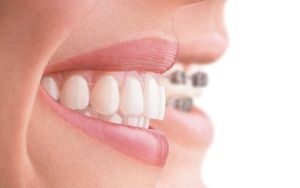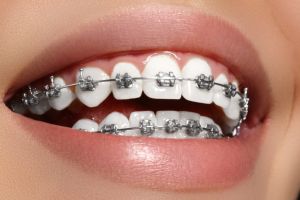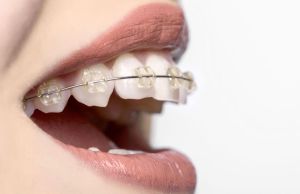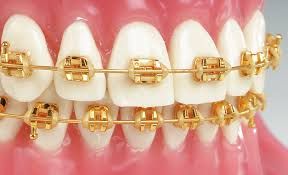What are Dental Braces?
Dental braces are devices that are placed directly on teeth in order to move them. For most of us, braces are the most common method for achieving optimally aligned teeth. Aside from straightening teeth, braces are used to improve the relationship of how our teeth come together between the upper and lower jaws. Braces for tooth movement fall under the dental specialty of “orthodontics” which is the study and treatment of improper bites (malocclusion). Orthodontic treatment with braces is used for cosmetic as well as functional improvement in respect to teeth position.

Different Types Of Braces
Metal wired braces
These are the most common and traditional type of braces. They are typically made out of stainless steel. Metal brackets are fixed (bonded) onto the teeth and secure a wire with elastic ties made out of rubber. As an alternative to using elastic ties, “self-ligating” brackets are used to clip onto the wire.
Ceramic wired braces
Also called “clear braces,” these provide a cosmetic alternative to the metal wired braces. The brackets are ceramic to match the shade of teeth and clear elastic ties are used. Self-ligating ceramic brackets are also available. The downside to ceramic braces is that they are more prone to breakage compared to the metal braces.
Lingual braces
These are braces that are placed on the lingual surface (backside) of the teeth and are not easily visible. This is mainly for cosmetic purposes and usually lengthens the time for treatment.
Other metal braces
Gold-plated stainless steel or titanium brackets are usually used for those with nickel allergies.
Clear aligners
These braces are made of a clear plastic that is custom-made without the use of brackets or wires on the teeth. These are also known as “clear braces” and present a very comfortable option for treatment. However, there are limitations to this method. Clear aligners can only tilt and rotate teeth in their position. Conversely, the use of brackets with traditional braces enables the whole bodily movement of a tooth (and its root) into the desired position.





How Do Braces Work?
Braces work by a slow and controlled process using force and constant pressure. For traditional braces, the wire that is attached to the brackets works to put pressure on the teeth to move to a specified direction.
Teeth move through a bio mechanical process called “bone remodeling.” When braces put pressure on a tooth, the “periodontal membrane” and bone surrounding this tooth are affected. The periodontal membrane completely surrounds a tooth in its socket and it essentially helps anchor the tooth to bone. With pressure from braces, the periodontal membrane of a tooth is stretched on one side and compressed on the other side. This effectively loosens the tooth out of its socket. The compressed side (the direction of pressure) is where bone is broken down to accommodate the new position of the tooth while the stretched side is where new bone is made. This process needs to be done very slowly and explains why wearing braces can take some time to achieve the desired results.

ADDRESS 1
Abha Tooth World
Janta Colony,
Near Chandra Medicos,
Vaishali Nagar,
Ajmer- 305001(Rajasthan), India.
Phone No: +91-8003217749
Email ID: Mohit07oblivion@gmail.com
Address 2
Abha Tooth World
Near Murjani Medicos,
Panchsheel B Block,
Panchsheel,
Ajmer - 305001(Rajasthan), India.
Phone No: +91-8003217749
EmailID:Mohit07oblivion@gmail.com
